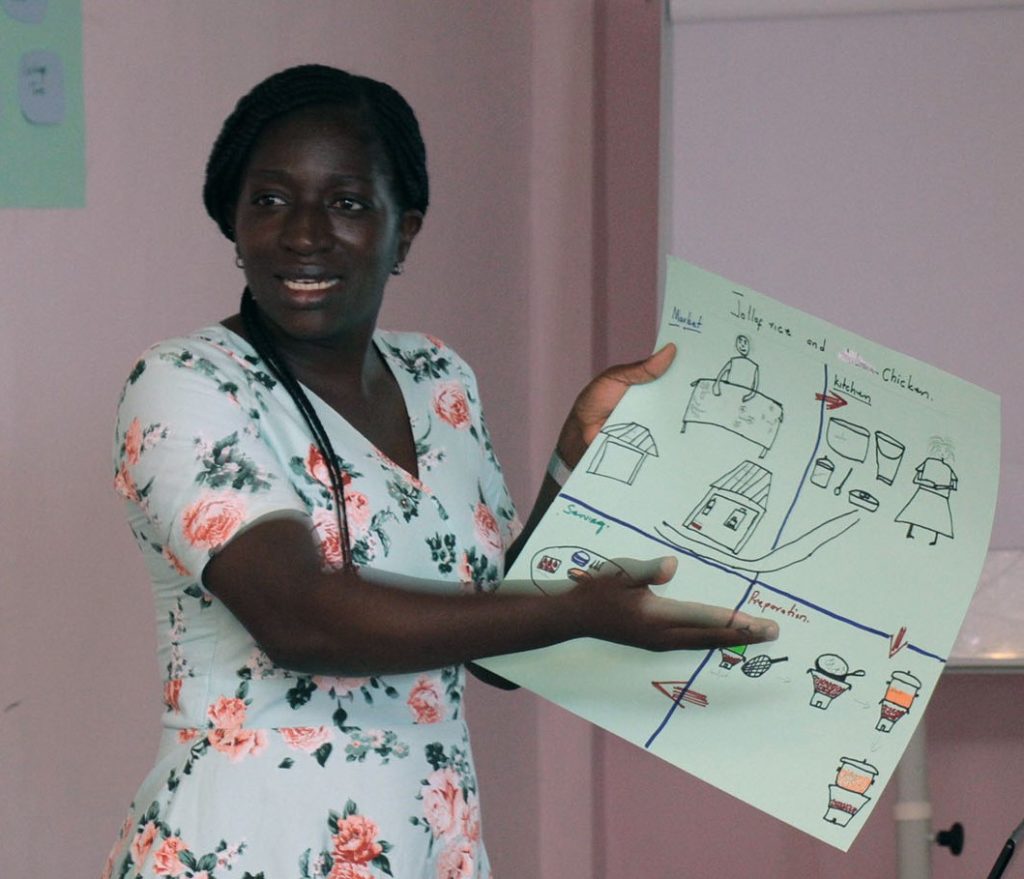Scientific African Journal has published peer-reviewed research led by a 2014 U.S. Department of Agriculture (USDA) Borlaug Fellow and her colleagues who investigated the commercial possibility of using soy flour in a West African staple food, gari. It is a breakthrough that the researchers state, “has huge potential to reduce iron deficiency anemia and protein-energy malnutrition among gari consumers in Africa.”
Ghanaian Research Scientist Leticia Amoakoah Twum and her colleagues at the Biotechnology and Nuclear Agricultural Research Institute (BNARI) found that an iron-fortified soy flour-gari blend not only produces a greater yield for consumption, but it also provides an increased nutritional value that traditional gari lacks. Consumers also like the slightly nutty taste of the soy flour gari.
To support the research, WISHH Africa Regional Director Josh Neiderman delivered U.S. soy flour to the BNARI team in April 2016. WISHH’s previous work in Liberia on a U.S. Agency for International Development (USAID) project also provided important field knowledge to share with the researchers on the production and positive acceptability of the soy-based gari, particularly for women and children.

Leticia praises her three months at Purdue University in Indiana as a Borlaug Fellow for providing her with valuable food technology training. The USDA Fellowship also included participation in the 2014 World Food Prize and International Borlaug Dialogue in Des Moines. “It was such an honor to be part of the World Food Prize, and I can boldly say it was part of my motivation to take up this project of improving the nutritional quality of gari.
“We were introduced to the inspiring legacy of Dr. Norman E. Borlaug,” Leticia adds. “That year, the Dialogue emphasized the power of intensifying, innovating, and inspiring to uplift smallholder farmers and meeting the increasing demand for nutritious food. My motivation on this project (soybean gari blend) was my little contribution to keeping the Borlaug legacy alive. I am proud of the result.”
Leticia also valued the Fellowship creating the opportunity for her to visit U.S. soybean farms. Upon her return to Ghana, she participated in a briefing with the USDA Foreign Agricultural Service Counselor Kurt Seifarth who told her about WISHH’s USAID-funded work in Liberia with the soy-based gari.
Gari, made from cassava tubers, is widely consumed in countries like Ghana and others along the West African coast. Despite its popularity, gari misses many essential nutrients that make up a healthy diet to promote growth and childhood development. Researchers, looking in part to address challenges that still face nutrient-deficient communities in West Africa, have long sought to take advantage of gari’s popularity to fight iron-deficiency in the area.
Leticia fondly recalls eating plenty of gari, which is commonly called a comfort food. She noted that parents often pack the ready-to-eat gari for their children as they send them to school. Gari also offers economic opportunities for women to manufacture and market.
Now, thanks to her work at BNARI, Leticia and her colleagues recommend the fortification of soybean gari with iron before roasting/heat treatment. The researchers are not only excited about the nutritional value this blend offers, but Leticia notes that adding soy flour increases the yield of the recipe — sometimes as much as double when compared to traditional gari. Thus, mothers and fathers can send their children to school with more food as well as the science that shows soy-based gari packs a greater nutritional punch thanks to the added soy flour.
Thanks to USDA and support from U.S. soybean organizations, WISHH continues to work with Leticia on commercialization strategies, taste testing, and education about the benefits of the soy-based gari for Ghana as well as other countries. She sees great potential to profitably market the product at the local level. Stay tuned–another peer-reviewed journal article on taste preferences is in the works.
